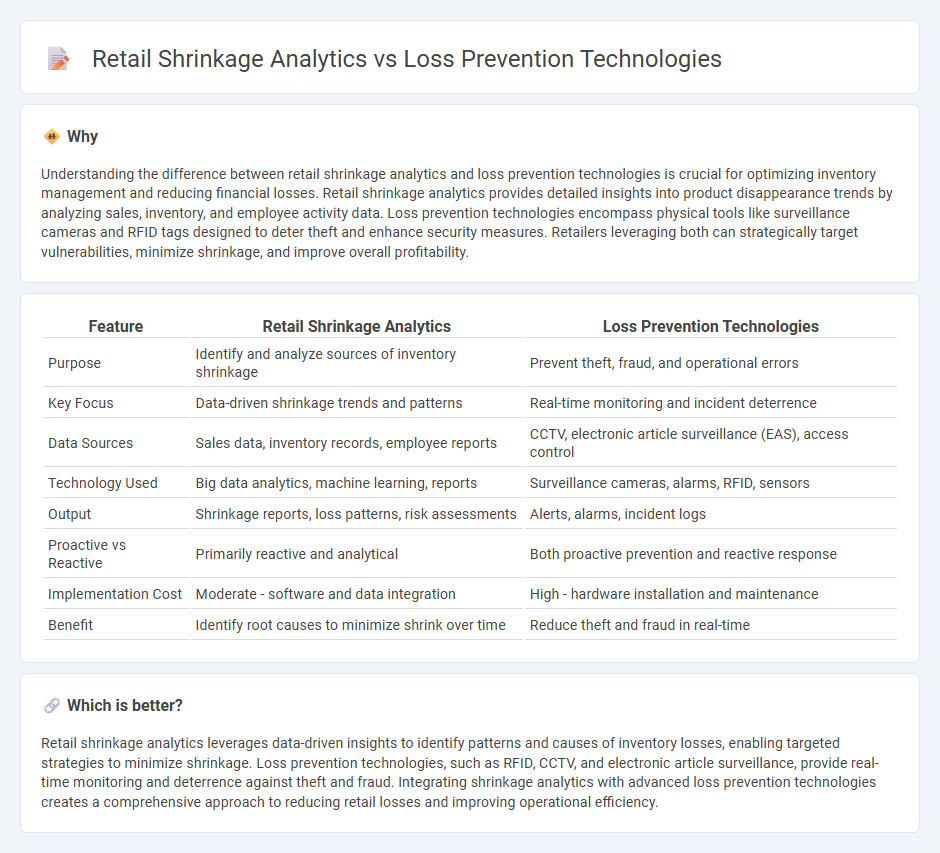
Retail shrinkage analytics harnesses data-driven insights to identify patterns and sources of inventory loss, enhancing the precision of loss prevention strategies. Advanced technologies like RFID, video surveillance, and AI-powered monitoring complement these analytics by providing real-time detection and deterrence of theft and operational inefficiencies. Explore how integrating shrinkage analytics with innovative loss prevention tools can significantly boost retail profitability and security.
Why it is important
Understanding the difference between retail shrinkage analytics and loss prevention technologies is crucial for optimizing inventory management and reducing financial losses. Retail shrinkage analytics provides detailed insights into product disappearance trends by analyzing sales, inventory, and employee activity data. Loss prevention technologies encompass physical tools like surveillance cameras and RFID tags designed to deter theft and enhance security measures. Retailers leveraging both can strategically target vulnerabilities, minimize shrinkage, and improve overall profitability.
Comparison Table
| Feature | Retail Shrinkage Analytics | Loss Prevention Technologies |
|---|---|---|
| Purpose | Identify and analyze sources of inventory shrinkage | Prevent theft, fraud, and operational errors |
| Key Focus | Data-driven shrinkage trends and patterns | Real-time monitoring and incident deterrence |
| Data Sources | Sales data, inventory records, employee reports | CCTV, electronic article surveillance (EAS), access control |
| Technology Used | Big data analytics, machine learning, reports | Surveillance cameras, alarms, RFID, sensors |
| Output | Shrinkage reports, loss patterns, risk assessments | Alerts, alarms, incident logs |
| Proactive vs Reactive | Primarily reactive and analytical | Both proactive prevention and reactive response |
| Implementation Cost | Moderate - software and data integration | High - hardware installation and maintenance |
| Benefit | Identify root causes to minimize shrink over time | Reduce theft and fraud in real-time |
Which is better?
Retail shrinkage analytics leverages data-driven insights to identify patterns and causes of inventory losses, enabling targeted strategies to minimize shrinkage. Loss prevention technologies, such as RFID, CCTV, and electronic article surveillance, provide real-time monitoring and deterrence against theft and fraud. Integrating shrinkage analytics with advanced loss prevention technologies creates a comprehensive approach to reducing retail losses and improving operational efficiency.
Connection
Retail shrinkage analytics leverage data from loss prevention technologies such as RFID tags, surveillance cameras, and POS systems to identify patterns and causes of inventory loss. Integrating real-time analytics with these technologies enables retailers to detect theft, errors, and fraud more efficiently, reducing financial losses. Advanced tools like AI-powered video analytics and predictive algorithms enhance the accuracy of shrinkage detection, optimizing inventory management and security protocols.
Key Terms
Loss prevention technologies:
Loss prevention technologies encompass advanced tools such as electronic article surveillance (EAS), RFID tagging, and CCTV systems aimed at reducing retail shrinkage by deterring theft and monitoring inventory in real time. These technologies provide actionable insights through automated alerts and data integration, enabling retailers to identify suspicious behaviors and prevent losses proactively. Explore how cutting-edge loss prevention solutions can revolutionize retail security and maximize profitability.
Electronic Article Surveillance (EAS)
Electronic Article Surveillance (EAS) is a cornerstone in loss prevention technologies, using tags and sensors to deter shoplifting and reduce retail shrinkage effectively. Retail shrinkage analytics complements EAS by analyzing data patterns to identify vulnerabilities and optimize security measures. Explore how integrating EAS with advanced analytics can significantly enhance loss prevention strategies.
RFID Tagging
RFID tagging enhances loss prevention technologies by providing real-time inventory tracking and accurate product identification, significantly reducing retail shrinkage caused by theft and misplacement. Retail shrinkage analytics leverage data from RFID systems to identify patterns and vulnerabilities in store operations, enabling targeted interventions. Explore how integrating RFID tagging with shrinkage analytics transforms retail loss prevention strategies.
Source and External Links
Intelligent loss prevention technologies - Facit Data Systems - Loss prevention technologies include AI-driven video analytics for real-time theft detection, RFID for inventory tracking, POS analytics to identify fraud, electronic article surveillance (EAS), biometric authentication, and cybersecurity measures, all working together to reduce retail shrinkage and improve operational efficiency.
Retail Loss Prevention: 4 Key Ways Technology Can Help - Verizon - Key technologies such as RFID for product tracking, AI-powered video surveillance, and 5G-enabled real-time analytics enable retailers to detect and prevent theft more effectively by monitoring shrinkage and suspicious activities promptly.
Retail Loss Prevention Solutions - Zebra Technologies - Retail loss prevention solutions leverage real-time visibility, RFID tracking, advanced analytics, and automated alerts to detect theft, fraud, and inventory issues early, allowing retailers to protect profits and maintain smooth operations without disrupting the customer experience.
 dowidth.com
dowidth.com